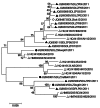Severe fever with thrombocytopenia syndrome virus among domesticated animals, China
- PMID: 23648209
- PMCID: PMC3647489
- DOI: 10.3201/eid1905.120245
Severe fever with thrombocytopenia syndrome virus among domesticated animals, China
Abstract
To investigate the infections of severe fever with thrombocytopenia syndrome virus (SFTSV) in domesticated animals, we sampled a total of 3,039 animals in 2 counties in Shandong Province, People's Republic of China, from April to November 2011. SFTSV-specific antibodies were detected in 328 (69.5%) of 472 sheep, 509 (60.5%) of 842 cattle, 136 (37.9%) of 359 dogs, 26 (3.1%) of 839 pigs, and 250 (47.4%) of 527 chickens. SFTSV RNA was detected in all sampled animal species, but the prevalence was low, ranging from 1.7% to 5.3%. A cohort study in 38 sheep was conducted to determine when seroconversion to SFTSV occured. SFTSVs were isolated from sheep, cattle, and dogs and shared >95% sequence homology with human isolates from the same disease-endemic regions. These findings demonstrate that natural infections of SFTSV occur in several domesticated animal hosts in disease-endemic areas and that the virus has a wide host range.
Keywords: China; Phlebovirus; SFTSV; domesticated animals; family Bunyaviridae; host; infection; pathogenic disease; prevalence; severe fever with thrombocytopenia syndrome virus; transmission; viruses; zoonoses.
Figures






References
-
- Jiang XL, Wang XJ, Li JD, Ding SJ, Zhang QF, Qu J, et al. Isolation, identification and characterization of SFTS bunyavirus from ticks collected on the surface of domestic animals [in Chinese]. Bing Du Xue Bao. 2012;28:252–7. - PubMed
-
- Zhang WS, Zeng XY, Zhou MH, Jiao YJ, Wen T, Guo XL, et al. Seroepidemiology of severe fever with thrombocytopeia syndrome bunyavirus in Jiansu Province [in Chinese]. Dis Surveill. 2011;26:676–8.
Publication types
MeSH terms
Substances
LinkOut - more resources
Full Text Sources
Other Literature Sources
Medical
Molecular Biology Databases
Miscellaneous
